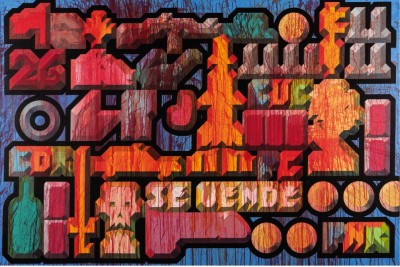
A burst of new painting from Glexis Novoa
Glexis Novoa is one of Miami’s more prominent and well-known artists. His black-and-white graphite constructs of a utopian metropolis gone wrong – cold, otherworldy, bereft of emotion – often site-specific to gallery and museum walls, have become part of the lexicon of contemporary art being made in Miami.
But before he set up in Miami in 1994, he was creating quite different, though still distinct and cutting-edge work, back in Havana, as part of a young generation of artists who had come of age in post-revolutionary Cuba. These earlier paintings were covered in color, and with references to propaganda posters and the literal lettering of the official messaging of the missionary socialist government. Novoa left it behind, but of course not the background and culture of the world in which he was raised. Twenty years later, Novoa returned to Havana and opened a studio.
The result is the solo painting exhibit at the Juan Ruiz Gallery, simply titled “Painting on Canvas.” For those of us here on this side of the Florida Straights, these large paintings look like an incredible departure – filled with bright colors, including purples and pinks. At first glance, most art lovers would not put Novoa as the brush master behind these.
But they are in fact harkening back to his early Havana days, and on closer inspection his thematic commentary on the nature of totalitarianism is just as present as his more recent works.
The hard fonts of a Soviet-style poster graphic can’t be softened by those violet and orange hues. The stellar painting “Se Vende” is really the centerpiece, as it pulls these elements together. Collaged together almost like block cuts are acronyms, simple images like a bottle or a bench or a sword, all covered in what seem like drips – that of blood, sweat of those toiling within this system?
One of those acronyms, CUC, is the focus of another superb painting. Like other Communist systems set up in the 20th century such as China, Cuba has a two-tiered system of currency, one only for natives and another tied to the U.S. currency – which, far from being egalitarian, ended up splitting the powerful from the far more numerous powerless, with a raging black market. “CUC” can be seen as the ultimate symbol of Cuban dysfunction.
There is a catalogue with an essay from curator Elizabeth Cerejido that accompanies this show, and goes into more depth about the history of Novoa’s work and the individual pieces in the exhibit.
Novoa has carved out a place here in Miami, but he is well on his way to becoming one of the more important contemporary Cuban artists in general.
“Painting on Canvas” runs through Nov. 22 at the Juan Ruiz Gallery, 301 N.W. 28th St., Miami; www.juanruizgallery.com.
Recent Content
-
Artsarticle ·
-
Artsarticle ·
-
Artsarticle ·
